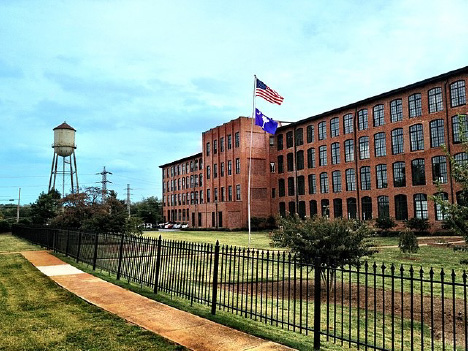South Carolina’s textile mills were the backbone of its economy for over a century, transforming the state from an agrarian society into an industrial powerhouse. The architecture of these mills reflects the history of labor, innovation, and community-building that shaped towns across the state. Today, while many textile mills have been shuttered or repurposed, their distinctive brick facades, towering smokestacks, and massive interiors remain a testament to South Carolina’s industrial past.
The Rise of Textile Mill Architecture
The late 19th and early 20th centuries saw an explosion of textile manufacturing in South Carolina, particularly in cities like Greenville, Spartanburg, Columbia, and Anderson. Textile mills were designed not only for production efficiency but also as defining elements of the communities they served. These large industrial complexes were typically constructed with red brick masonry, tall windows for natural lighting, and slow-burning timber or reinforced concrete floors—a technique designed to prevent fires in an industry prone to dust and lint accumulation.
The New England textile mill model influenced many of South Carolina’s mills, which prioritized multi-story buildings with open floor plans for machinery and workers. Engineers like D.A. Tompkins, an influential figure in Southern industrialization, helped spread these architectural principles across the state, designing mills that maximized both function and economy.
Iconic South Carolina Textile Mills
- Drayton Mill (Spartanburg, SC) One of the most well-preserved textile mills in South Carolina, Drayton Mill, was built in 1902 and operated for nearly a century before closing in 1994. Designed with large arched windows, towering smokestacks, and massive brick structures, Drayton was a self-sustaining industrial community with worker housing, a mill school, and a company store. Today, the mill has been revitalized as Drayton Mills Lofts, a mixed-use development that retains much of its historic charm while providing modern residences and commercial spaces.
- Brandon Mill (Greenville, SC) Built in the early 1900s, Brandon Mill was one of the largest textile producers in the region and employed thousands of workers. The mill complex included a village with company-owned homes, a school, and a church, demonstrating how these structures shaped entire communities. Today, the revitalized mill serves as Brandon Mill Lofts, preserving its architectural integrity while offering new residential and creative spaces.
- Olympia Mill (Columbia, SC) At its peak, Columbia’s Olympia Mill was one of the largest cotton mills in the world, operating with thousands of workers under one roof. Built in 1899, the mill’s design featured Romanesque Revival detailing, an architectural style that added grandeur to industrial buildings. Like many of its counterparts, Olympia Mill has since been adapted into Olympia Mill Village Lofts, ensuring this historic site’s continued use and appreciation.
Preserving and Repurposing Textile Mill Architecture
With the decline of textile manufacturing in the late 20th century, many South Carolina mills fell into disrepair. However, preservation efforts have sought to revitalize these structures, turning them into residential lofts, office spaces, and cultural centers. Adaptive reuse projects preserve historic architecture and support economic development by bringing new life to these once-thriving industrial landmarks.
Organizations like Preservation South Carolina and Historic Columbia have been instrumental in advocating for the protection of these mills, ensuring they remain part of the state’s architectural heritage. These efforts highlight how, once symbols of labor and production, industrial structures can be reimagined as places of community, creativity, and civic pride.
For more on this topic, see:
Historic Columbia – Olympia Mill
IMAGE

Morgan Mill – Greenville, SC

